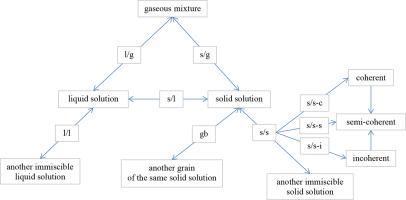Advances in Colloid and Interface Science ( IF 15.9 ) Pub Date : 2020-07-19 , DOI: 10.1016/j.cis.2020.102212 George Kaptay 1

|
In this paper first a generally valid model is derived from the two fundamental equations of Gibbs for temperature and composition dependences of all types of interfacial energies. This general model is applied here to develop a coherent set of particular model equations for surface tension of liquid metals and alloys, for surface energy of solid metals and alloys, for high-angle grain boundary energy in metals and alloys, for solid/liquid interfacial energy in metals and alloys, for liquid/liquid interfacial energy in alloys and for solid/solid interfacial energy in metals and alloys. The latter case is sub-divided into models on coherent, incoherent and semi-coherent interfaces with the same phases and with different phases on the two sides of the interface. Model parameters are given here as an example for the 111 plane of fcc metals and alloys. For other crystal planes or other crystal structures the model parameters should be adjusted, while the model equations remain the same. The method is demonstrated on various surface and interfacial energies of pure Au, on solid/liquid interfacial energy in the AlCu system, on different types of solid/solid interfacial energies in the Au
Ni system, on solid/solid, solid/liquid and liquid/liquid interfacial energies in the Al
Pb system and on the coherent, incoherent and semi-coherent interfacial energies between ordered and disordered fcc phases in the Ni-rich part of the Ni
Al system. The ability of this method is demonstrated to predict surface and interface transition along free surfaces and grain boundaries and also negative interfacial energies in nano-systems.
中文翻译:

一组用于液体和固体金属及合金的系统中各种表面和界面能的连贯模型方程。
在本文中,首先从吉布斯的两个基本方程式推导出一个普遍有效的模型,该模型适用于所有类型界面能的温度和成分依赖性。在此应用此通用模型来开发一组相干的特定模型方程组,这些模型方程组包括液态金属和合金的表面张力,固态金属和合金的表面能,液态金属和合金的高角度晶界能,固态/液态界面金属和合金中的能量,合金中的液体/液体界面能以及金属和合金中的固体/固体界面能。将后一种情况细分为相干,不相干和半相干界面的模型,这些界面在界面的两侧具有相同的相位和不同的相位。此处给出的模型参数是fcc金属和合金的111平面的示例。对于其他晶面或其他晶体结构,应调整模型参数,而模型方程式保持不变。在纯金的各种表面和界面能,铝中的固/液界面能上证明了该方法Cu体系,Au
Ni体系中不同类型的固体/固体界面能,Al
Pb系统中的固体/固体,固体/液体以及液体/液体界面能以及之间的相干,非相干和半相干界面能Ni
Al系统的富Ni部分中有序且无序的fcc相。证明了该方法的能力可以预测沿自由表面和晶界的表面和界面过渡,以及纳米系统中的负界面能。











































 京公网安备 11010802027423号
京公网安备 11010802027423号